‘Operation Baltic Guardian’
Nation and WorldSUMMARY: JMU students participated in “Operation Baltic Guardian,” a simulation held in conjunction with the U.S. Department of State and set against the backdrop of the 75th anniversary of NATO. The simulation gave students from diverse majors firsthand experience in international diplomacy and defense.
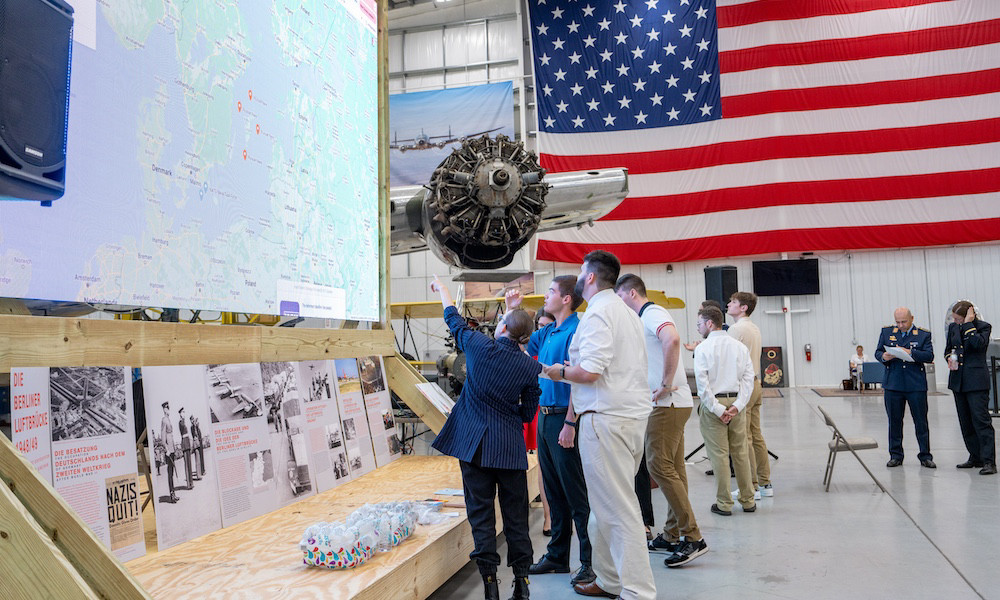 |
| “Operation Baltic Guardian” played out on a giant projection screen in Dynamic Aviation’s hangar in Bridgewater, Virginia. |
On a foggy autumn morning, Russian naval forces suddenly initiate a blockade of the Swedish island of Gotland in the middle of the Baltic Sea. The blockade consists of several small warships and destroyers, effectively cutting off all sea traffic to and from the island.
The Swedish government quickly declares the blockade a hostile act and demands the immediate withdrawal of Russian forces. However, intelligence reports suggest that additional Russian ships, including amphibious assault vessels, are en route, potentially indicating preparations for a full-scale invasion to seize the island. All power, telecommunications and internet on the island have been shut off.
Russia insists the blockade is defensive in nature, citing recent provocations and NATO’s “aggressive military exercises” in the region. Moscow says the move is aimed at “ensuring the security of vital shipping lanes and safeguarding Russian interests.” However, Finland and its Baltic neighbors believe Russia is trying to unilaterally redraw maritime borders in the Gulf of Finland. The Russian Foreign Ministry previously claimed the borders are based on outdated maps and should be reassessed.
Gotland is home to approximately 58,000 civilians, along with a limited Swedish military garrison that is ill-equipped to repel a major assault. With Russian air and naval superiority in the immediate vicinity, Sweden finds itself in a precarious position.
Sweden immediately invokes its NATO membership and calls for support to counter the Russian threat. In response, NATO members convene an emergency meeting to discuss intervention options.
***
 |
| Political science professor Bernie Kaussler, who developed the simulation, delivers opening remarks. |
That was the scenario developed by political science professor Bernie Kaussler for JMU’s Diplomacy & Defense Lab, a collaboration with the Department of State that allows students to practice their statecraft, negotiation and strategy skills.
The simulation, “Operation Baltic Guardian,” unfolded in September on the 75th anniversary of NATO at Dynamic Aviation in nearby Bridgewater, Virginia. The company’s fleet includes a Douglas C-47 military transport plane — the same model used during the Berlin Airlift of 1948-49, one of the first international crises of the Cold War and a precursor to NATO.
The simulation was co-sponsored by the Germany Embassy in Washington, D.C., as part of its Germany on Campus initiative. Kaussler applied for a small grant to display an exhibit on the Berlin Airlift in Miller Hall and invited the embassy’s deputy defense attaché, Col. Alexander Brand, and his team to attend the simulation and serve as national security advisers to all of the teams.
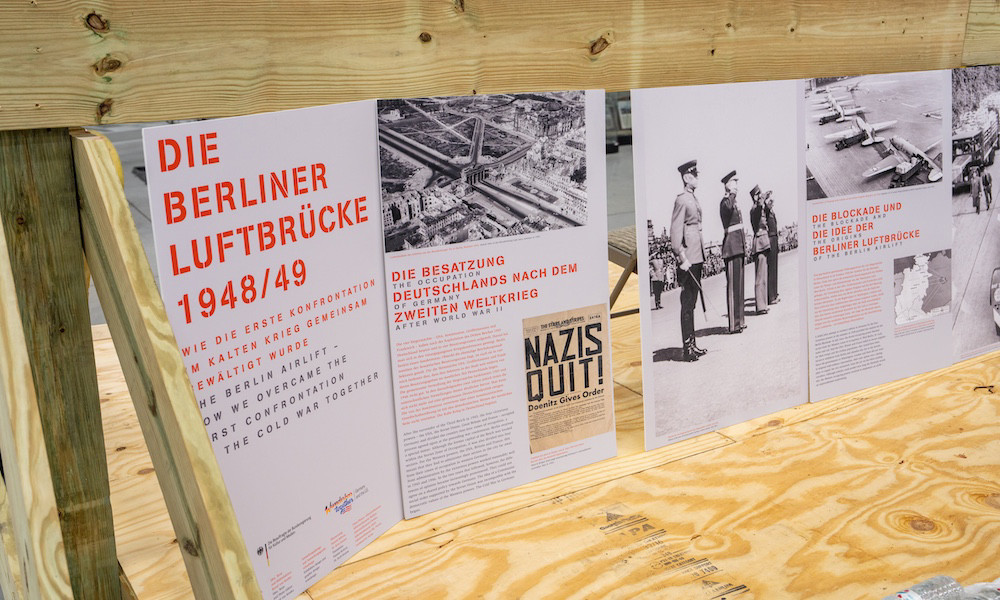 |
| The simulation unfolded on the 75th anniversary of the Berlin Airlift of 1949-49, one of the first international crises of the Cold War. |
|
“The last few years have shown us that [through] the use of military force, of political violence and all of its manifestations … sometimes reality is stranger than fiction. As crazy as it might sound, this is part of preparing future national security leaders, diplomats and intelligence officers like yourselves.” — Bernie Kaussler, political science professor |
The students, from Computer Science, Engineering, German, History, International Affairs, Political Science and ROTC, were divided into eight teams representing Russia, Sweden and its NATO allies. Students were allowed to choose their team, although those countries with nuclear capability — France, Russia, the United Kingdom and the United States — were reserved for ROTC cadets.
Each team was given eight moves to accomplish a list of objectives based on their nation’s strengths and interests. The moves, which played out on a giant projection screen in Dynamic Aviation’s hangar using Google Maps, could be conducted openly or in secret.
Among Team Russia’s primary objectives was to advance and legitimize territorial gains in the region, particularly in areas with contested borders. “We’re trying to take the territory back,” said Mae Jacobs, a sophomore ROTC student and member of Team Russia. “If you control the island, you can prevent other navies from getting through the Baltic Sea and up to Russia, which is big.
“As far as how we’re going to do that,” she added, “we don’t know yet, but all options are on the table.”
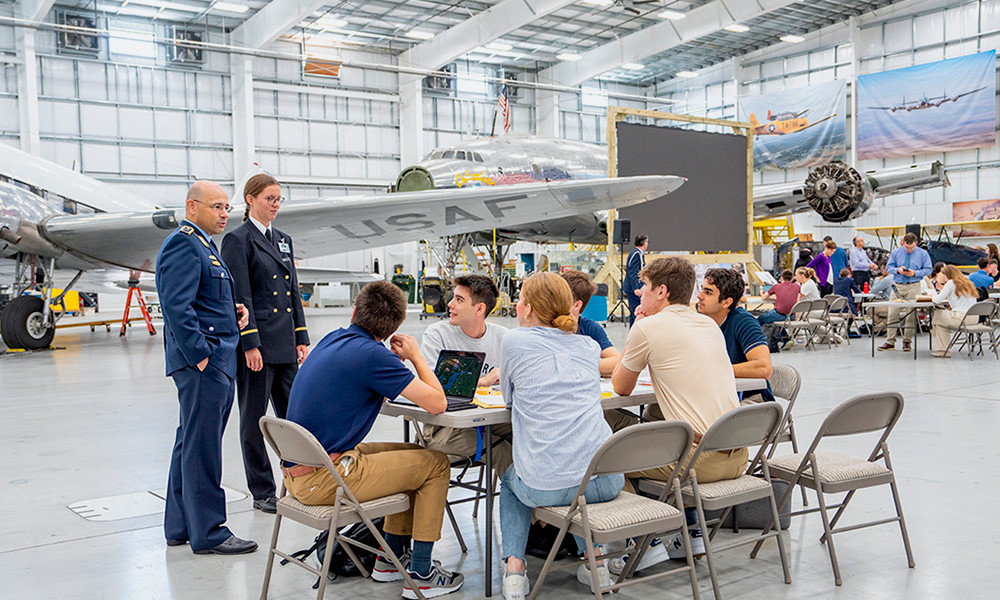 |
| Master Sgt. Alexander Nickel and Lt. Johanna Behr, from the Germany Embassy in Washington, D.C., advise Team Russia. |
Team Sweden, meanwhile, was focused on defending Gotland and its civilian population.
“We’re trying to protect our sovereignty, while also not causing too big of an incident,” said Dylan Bencivengo, a senior Political Science major. “We’re not a nuclear power like some of the others, but we’re going up against one [in Russia], which adds a whole new dynamic.”
His teammate, Juana Hernandez, a junior International Affairs major, said that dynamic was one of the reasons why she chose Team Sweden. “It’s our island,” she said. “We’re a major player. We’re defending our nation rather than just helping someone else.”
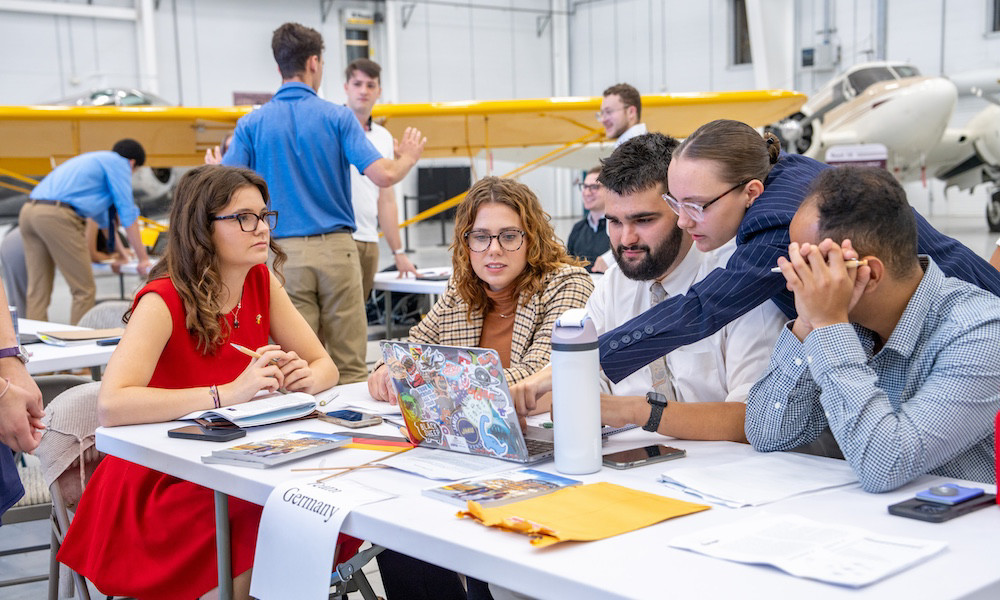 |
| Team Germany discusses strategy. |
Sharing a coastline with the Baltic Sea, Team Germany was charged with leading an airlift operation to Gotland as well as deploying its navy to help NATO break the blockade of the island. But early in the game the group was treading lightly.
“We definitely don’t want war with Russia, as that could potentially lead to nuclear conflict. We’re already struggling with supporting Ukraine in its war. So, I think our main goal is a solution that maintains NATO borders and keeps Russia out of our direct shipping route.”
— Grace Mensch, Team Germany
Team USA was busy coordinating NATO’s military response to the crisis, while also monitoring Team Russia’s moves and engaging in high-level talks with Moscow to avoid further escalation.
“If it becomes necessary, our Second Fleet [U.S. Navy] carrier groups are on standby [in the North Atlantic],” said Ryan Nguyen, a first-year ROTC student. “We also have bases in Germany that we can use to support our allies in the region.”
“It’s pretty hectic right now,” he added. “There’s a lot of confusion.”
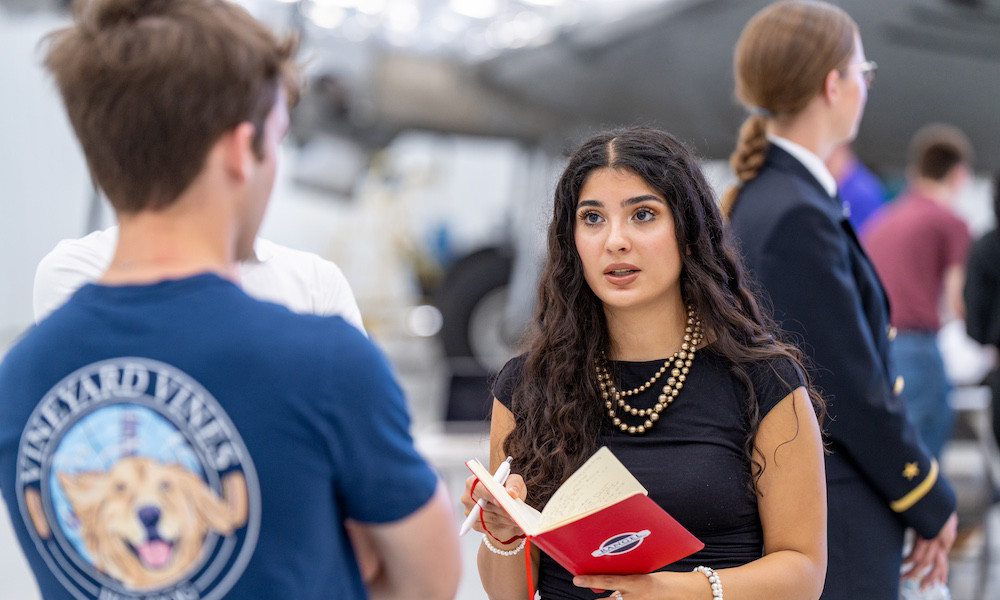 |
| Bella Santos, a member of Team UK, was among those pushing for a diplomatic solution to the crisis. |
While other NATO countries focused on military maneuvers, Team UK was pushing for a diplomatic solution to the crisis. The United Kingdom “wants to be a leader in forming coalitions between member states of the European Union as well as other countries in Europe,” said Bella Santos, a senior majoring in Political Science and International Affairs.
Santos and her teammates were frustrated by the lack of communication and coordination among NATO members. “We just came out of a meeting with Russia, and it seemed promising, about them moving their troops out of Latvia,” she said. “We started moving our ships out of the region. But before we were able to talk to them again, [NATO] announced that it’s going forward with initiating a blockade on St. Petersburg and Kaliningrad.”
|
“We’ve been trying to push diplomacy, and everyone just keeps saying, ‘No, it’s not an option.’” — Corinne Privitera, Team UK |
“We’ve been trying to push diplomacy, and everyone just keeps saying, ‘No, it’s not an option,’” added Corinne Privitera, a senior Political Science major. “We’ve been backed into a corner.”
A voice announces new developments playing out on the screen: “The U.S. Second Fleet is moving into the northern Atlantic. The British fleet is leaving its home in Southampton and steaming toward the Norwegian Sea.”
After nearly two hours, the simulation ended with tensions high and both sides seemingly on the brink of armed conflict. Still, the students successfully implemented an airlift to supply Gotland with vital resources and evacuate Swedish civilians, and NATO navies staged a counter blockade against Russian forces in the Gulf of Finland as well as in the Baltic Sea.
“None of the teams rushed aggressively out of fear of ending up in a shooting war,” Kaussler said, “yet at the same time Western allies showed strength and drew a line in the sand — or rather in the Baltic Sea — that an attack on the island would not be tolerated. And while at times there was a lack of communication between allies, teams followed their respective objectives of forcing the Russians to retreat.”
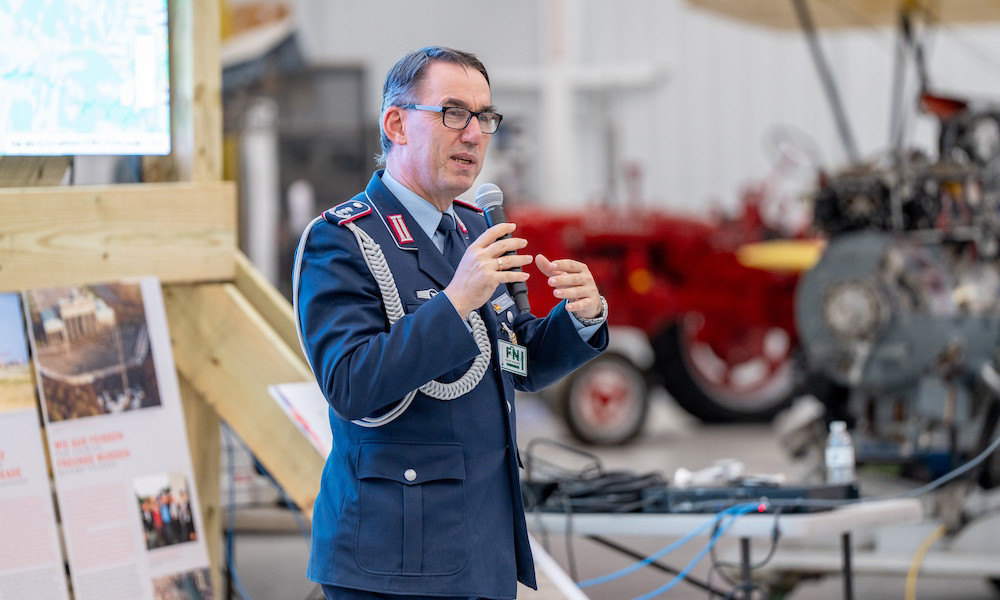 |
| ”The situation escalated relatively quickly, because certain countries did things on their own without conferring with one another,” offered Col. Alexander Brand, deputy defense attaché at the German Embassy, during the debriefing session. |
During the debriefing session, members of the German consulate shared their assessment of the teams’ performance.
“I think initially there was not a lot of interaction between different countries,” said Col. Brand. “You did not talk strategy from the get-go, and then you went with a common strategy to counter the Russian threat, or perceived threat. The situation escalated relatively quickly, because certain countries did things on their own without conferring with one another.”
His colleague, Master Sgt. Alexander Nickel, agreed. “From the beginning, think bigger and not so unilateral,” he advised. “Try to show that you have allies and partners. That makes you a stronger community than your opponent.”
The students were grateful for the experience.
Jacobs, who is minoring in Russian, believes her role with Team Russia helped her understanding of Russian politics. She is interested in pursuing a career as a military lawyer.
“I’ve done some gaming before, so this is a lot of fun,” she said, adding, “I think it’s really helpful to put us in these positions to help us learn in a safe environment where our decisions don’t have actual consequences.”
***
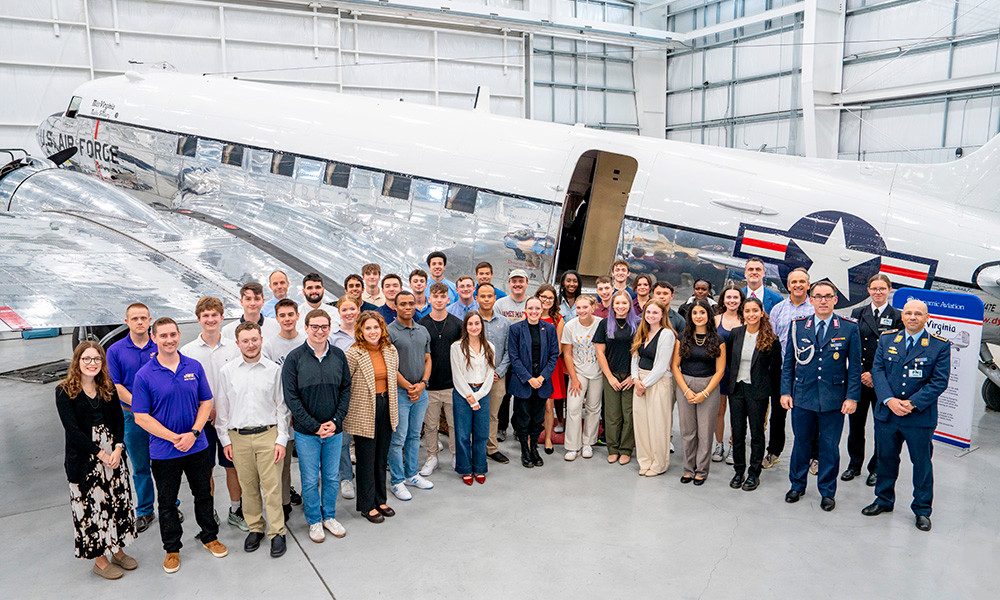 |
| Participants pose in front of Dynamic Aviation's Douglas C-47 military transport plane — the same model used during the Berlin Airlift of 1948-49. |

